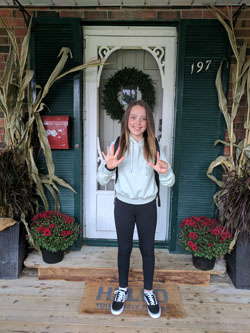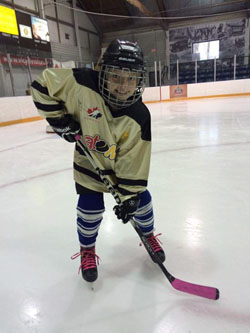Changing the face of cancer care at home and around the world
Summary:
Paediatric brain tumour biopsies from across Canada and around the world are being analyzed at SickKids using new, state-of-the-art diagnostic, prognostic and predictive tests for childhood cancers.
SickKids-developed diagnostic tests lead to the right treatment at the right time
TORONTO – Paediatric brain tumour biopsies from across Canada and around the world are being analyzed at The Hospital for Sick Children (SickKids) using new, state-of-the-art diagnostic, prognostic and predictive tests for childhood cancers.
“Using the latest technologies, we have developed and are offering novel diagnostic tests that are beginning to change how kids’ cancers are treated. These tests are giving oncologists more information than was previously available, enabling them to give their patients the right treatment at the right time, and avoiding unnecessary therapies and associated side-effects, ” says Dr. Cynthia Hawkins, Neuropathologist and Senior Scientist at SickKids.
Over the past decade there have been many high-impact, genomics-driven cancer discoveries in paediatrics. The challenge is moving these discoveries from the lab to the clinic where they can impact how kids are diagnosed and treated. Hawkins and her team have done just that. They have taken these discoveries from the research setting, and developed robust and clinically-validated tests for childhood cancers including low-grade glioma, medulloblastoma, sarcoma, and acute lymphoblastic leukemia. These tests are looking at the molecular biology of the patient’s cancer and providing information indicating how a patient will respond to specific drugs, how their tumour will behave over time and likely outcomes for the patient’s specific cancer.
“The difference these diagnostic tests are making is night and day,” says Dr. Eric Bouffet, Head of Neuro-oncology and Senior Associate Scientist at SickKids. “Instead of a taking a one-size fits all approach, this is individualized cancer care at its best.”

SickKids patient Julia van Damme, 12, was diagnosed with a low-grade glioma brain tumour in 2013. It was discovered at a routine eye appointment that she had 20/20 vision in one eye, but was near blind in the other. After a series of investigations and eventually an MRI, her eye doctor shared the devastating news that Julia had a brain tumour. She was referred to SickKids, where a brain biopsy was performed. The tissue sample collected during the biopsy was then tested using the new technology, which revealed that she had the BRAF V600E mutation. The test not only confirmed that it was low-grade glioma but also took a closer look at the molecular biology of the specific tumour. “This molecular information allowed us to make decisions that were specific to Julia, not just specific to low-grade glioma,” says Bouffet. “She received an initial chemotherapy regimen which stabilized the tumour, but had minimal results. As the disease started to show further progression, instead of a more aggressive chemotherapy and radiation she received a targeted daily oral medication.”

Julia takes this pill at home every day and has responded very well to the treatment. She is able to continue with school, sports and other activities.
Low-grade glioma is the most common brain tumour in kids, affecting about 25- to 30,000 children worldwide. Traditionally, all low-grade gliomas were managed and treated the same way. A child would typically be diagnosed based on their presenting symptoms (which could start as headaches, instability, weakness or vision problems) in addition to brain imaging showing a mass on the brain. Depending on where the tumour is located, the clinical team would decide whether or not it could be removed. They would then begin the standard therapy of chemotherapy and radiation.
The trouble is that not all tumours behave the same or respond to treatment the same way, says Dr. Uri Tabori, Staff Oncologist and Senior Scientist at SickKids. A recent international study led by SickKids researchers published in the Journal of Clinical Oncology found that kids like Julia, who have low-grade glioma with a genetic mutation called BRAF V600E, do not respond well to the standard chemotherapy and radiation, experience high rates of relapse and have worse outcomes. However, the research team also found that these patients do respond well to a targeted drug, which means the standard therapy could theoretically be avoided all together and the patient could take an oral treatment instead. “Having this molecular information about our patients’ specific tumour is critical at the beginning before their treatment course starts,” says Tabori, who is also co-author of the study.
As a result of this work, co-authors Bouffet, Hawkins and Tabori recommend biopsying all low-grade gliomas to uncover the molecular underpinnings, so oncologists can determine the appropriate course of treatment for each patient. Research papers commonly make recommendations like this in their conclusions, but in practice clinicians are not actually able to immediately test their patients for these subgroupings because the clinical technology has just not been as advanced as the research technology. SickKids has already translated these findings into clinical diagnostic tests so it is possible to test low-grade glioma patients for this mutation upon diagnosis.
“On one side, it is more aggressive to biopsy everyone, but since the testing is so much more sophisticated it is allowing us to tailor treatment right from the beginning,” says Bouffet. The SickKids team is working towards developing a blood test to eventually replace brain biopsy, which would be less invasive for the patient and allow for both diagnosis and monitoring response to therapy in a cost-effective and safe way.
Low-grade glioma is just one example of how these diagnostic tests are laying the groundwork for individualized cancer care.
“Essentially we are using these diagnostics to change the care path, based on the new testing that is available,” says Hawkins. “As a clinician-scientist, it can sometimes be frustrating that we make a number of discoveries in the lab but we can’t immediately use these findings to treat our patients. It feels amazing that we can now use these tests to help inform life-altering decisions for our patients. What’s even better is this isn’t just helping SickKids patients, but kids with cancer across the country and around the world.”

SickKids has become the referral centre for diagnostic tests for paediatric cancer. In the last year, Hawkins and her team have analyzed 60 brain tumours from SickKids patients, and over 150 from around the world including the United States, Australia, New Zealand, as well as for countries with limited cancer resources like Jordan, Pakistan and Morocco.
This transformation of clinical cancer diagnostics at SickKids is supported by the Government of Canada through Genome Canada and the Ontario Genomics Institute, the Garron Family Cancer Centre at SickKids, Labatt Brain Tumour Research Centre at SickKids, Ontario Centre for Excellence through the Medical Sciences Proof-of-Principle (MSc PoP) program funded by the Government of Ontario, PLGA Foundation USA, Making Headway Foundation USA, BRAINchild Canada, Meagan’s Walk, NanoString Technologies and RainDance Technologies, a wholly owned subsidiary of Bio-Rad Laboratories, Inc, and SickKids Foundation.
About The Hospital for Sick Children
The Hospital for Sick Children (SickKids) is recognized as one of the world’s foremost paediatric health-care institutions and is Canada’s leading centre dedicated to advancing children’s health through the integration of patient care, research and education. Founded in 1875 and affiliated with the University of Toronto, SickKids is one of Canada’s most research-intensive hospitals and has generated discoveries that have helped children globally. Its mission is to provide the best in complex and specialized child and family-centred care; pioneer scientific and clinical advancements; share expertise; foster an academic environment that nurtures health-care professionals; and champion an accessible, comprehensive and sustainable child health system. SickKids is proud of its vision for Healthier Children. A Better World. For more information, please visit www.sickkids.ca. Follow us on Twitter (@SickKidsNews) and Instagram (@SickKidsToronto).
Media contacts
Caitlin Johannesson
The Hospital for Sick Children
416-813-7654, ext. 201436
caitlin.johannesson@sickkids.ca
Suzanne Gold
The Hospital for Sick Children
416-813-7654, ext. 202059
suzanne.gold@sickkids.ca

